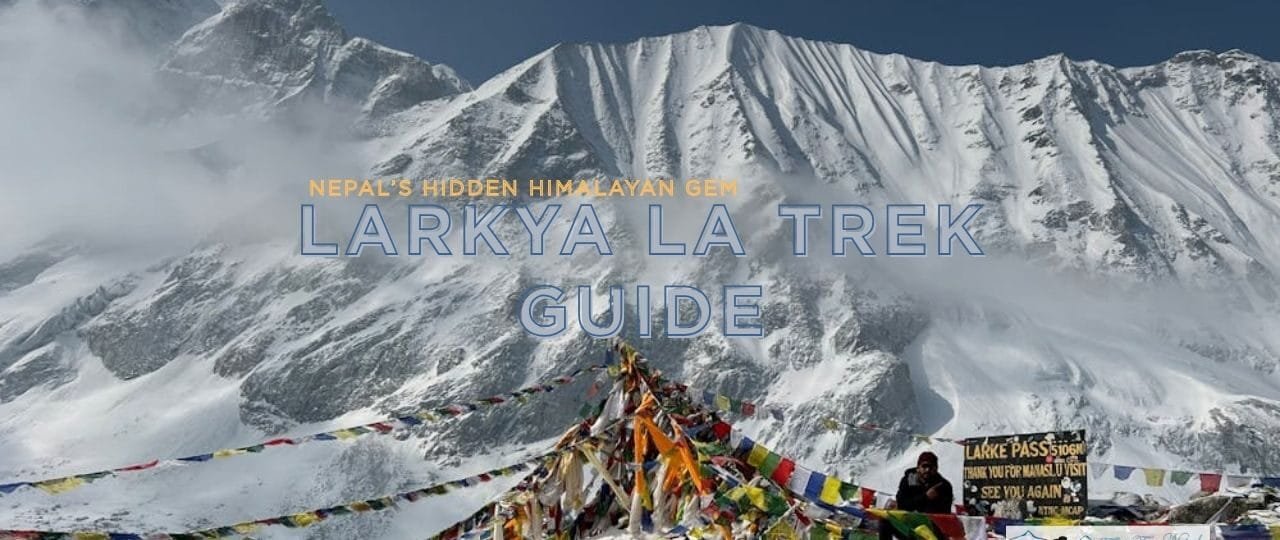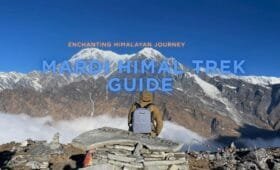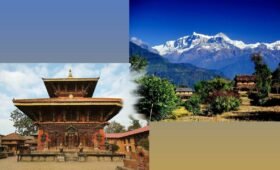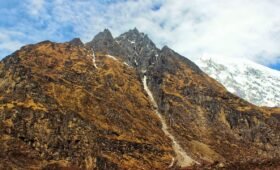The Larkya La Trek is an awe-inspiring high-altitude adventure in the Manaslu region of Nepal, famed for its rugged mountain passes, secluded villages, and pristine natural beauty. Often paired with the Manaslu Circuit Trek, the Larkya La Pass Trek grants an up-close look at Mount Manaslu (8,163m)—the eighth-highest peak in the world—while crossing Larkya La Pass, one of the region’s most spectacular and challenging passes, for intrepid travelers seeking a path less congested than Everest or Annapurna, the Larkya La Trek stands out for its untamed landscapes, centuries-old monasteries, and a rich cultural mosaic shaped by Tibetan-influenced communities.
This comprehensive Larkya La Trek Guide article will delve into every dimension of the Larkya La Trek. We’ll cover the essential Trek Itinerary, dissect the Trek Cost, evaluate the route’s difficulty and distance, and highlight the best time to embark. We’ll also explain how to combine your trek with philanthropic travel via Volunteers Initiative Nepal (ViN). Whether you’re an experienced trekker aiming for a new high pass or a cultural enthusiast drawn to remote Himalayan enclaves, the Larkya La Trek provides a unique synergy of scenic wonder and cultural immersion.
Introduction
1. Introduction: Why Choose the Larkya La Trek?
The Larkya La Trek weaves through the Manaslu Conservation Area, culminating in the Larkya La Pass Trek crossing at 5,160 meters (some references put it at ~5,160–5,200m). Crossing Larkya La is often considered the highlight of the route as part of the broader Manaslu Circuit Trek—an alpine vantage offering 360-degree panoramas of Manaslu, Himalchuli, and more. Because the region is classified as a restricted zone, visitor numbers remain lower than the throngs on the Annapurna or Everest circuits.
Statistic: According to the Nepal Tourism Board, fewer than 10,000 foreign trekkers visit Manaslu annually, starkly contrasting to the 150,000-plus who explore Annapurna each year. This exclusivity fosters an atmosphere of tranquility and authenticity—two hallmarks that set Larkya La Trek apart.
“The Larkya La Trek was a revelation. Each day brought new cultural touches and mountain vistas unspoiled by heavy crowds. Summiting Larkya La Pass at dawn was arguably my most triumphant Himalayan moment,”
says Martina, a 34-year-old trekker from Germany.
Geography
2. Geographic & Cultural Backdrop
The Manaslu Circuit Trek—which envelops Larkya La—lies near the Tibetan border in north-central Nepal. Sparsely populated Gurung and Tibetan communities define the region, preserving ancient Buddhist customs, fortress-like villages, and centuries-old monasteries. The area was only opened to outsiders in the early 1990s, ensuring it retains a rustic, off-the-beaten-path allure.
Trek Route meanders through terraced farmland at lower altitudes (~700–1,500m), transitioning to coniferous forests and then alpine meadows above 3,000m. Eventually, you tackle the harsh, glaciated terrain of the pass near 5,160m. Yak caravans, chortens, and prayer flags remind you of the strong Tibetan cultural influences, while teahouses provide essential comfort. Temperatures, local customs, and the terrain shift as you ascend—granting a dynamic cultural and environmental immersion.
Trek Itinerary
3. Larkya La Trek Itinerary
Though varied approaches exist, a standard Larkya La Trek Itinerary merges seamlessly with the broader Manaslu circuit. Below is an indicative 14–16-day itinerary from Kathmandu, with ~5–6 hours of trekking daily:
Day 1: Drive Kathmandu → Soti Khola (~700m)
~7–8 hour bus or jeep ride. Overnight in a riverside teahouse.
Day 2: Soti Khola → Machha Khola (~900m)
~5–6 hours through farmland and small hamlets. Steep ridges overshadow the Budhi Gandaki River.
Day 3: Machha Khola → Jagat (~1,340m)
~6–7 hours crossing multiple rapids, stepping deeper into the Manaslu region.
Day 4: Jagat → Deng (~1,860m)
Permit checks at Jagat. Gradual climbs through terraced fields and scenic villages.
Day 5: Deng → Namrung (~2,660m)
~7 hours. First glimpses of Manaslu’s snowy peaks if the weather is clear.
Day 6: Namrung → Lho (~3,180m)
A shorter ~4-hour day. Buddhist monasteries, expansion of Tibetan culture.
Day 7: Lho → Samagaon (~3,530m)
~5 hours. En route, striking vistas of Himalchuli, Manaslu. Samagaon is a major cultural hub.
Day 8: Acclimatization at Samagaon
Optional day-hike to Pungyen Gompa (~4,000m) or explore glacial ridges.
Day 9: Samagaon → Samdo (~3,875m)
~3–4 hours. Gentle ascents, close to the Tibetan border.
Day 10: Samdo → Dharamsala (~4,460m)
A short ~4-hour day ensuring rest before tackling Larkya La.
Day 11: Cross Larkya La Pass (~5,160m) → Bimthang (~3,720m)
Key highlight day ~8–9 hours. Start pre-dawn. The pass offers epic Manaslu panorama.
Day 12: Bimthang → Gho (~2,560m)
A ~5–6 hour descent across forests and meadows.
Day 13: Gho → Dharapani (~1,920m)
~5 hours linking with the Annapurna circuit route.
Day 14: Drive Dharapani → Besisahar → Kathmandu
A ~7–9 hour combination of jeep and bus rides, returning you to the capital.
Larkya La Trek Duration typically ~12–14 trekking days plus 1–2 buffer days, so 14–16 days total from Kathmandu. Some expansions incorporate Tsum Valley or skip certain villages for a shorter route. Regardless, crossing Larkya La Pass is the ultimate highlight.
Trek Cost
4. The Larkya La Trek Cost
Restricted area permits, staff wages, lodging, and your chosen route length shape Trek Cost. Key budget items:
- Transport
- Bus from Kathmandu to Arughat or Soti Khola (~USD 10–15). Jeep hires are pricier (~USD 120–200), group-sharing recommended.
- Permits
- Manaslu Restricted Permit: ~USD 100/week (peak season, Sep–Nov) or ~USD 70/week (Dec–Aug). Additional days cost extra (~USD 15 per day).
- Annapurna Conservation Area Permit (ACAP) ~USD 30.
- Manaslu Conservation Area Permit (MCAP) ~USD 30.
- Possibly a TIMS card (~USD 10–20).
- Guide & Porter
- A licensed guide is mandatory in restricted zones (~USD 25–30/day). Porters ~USD 15–25/day.
- Food & Lodging
- Teahouses: ~USD 3–6 per night at lower altitudes, ~USD 5–10 higher up. Meal costs ~USD 5–8 each.
- Misc
- Wi-Fi (~USD 2–5), hot showers (~USD 2–4), device charging (~USD 1–2).
- Extra days or expansions add daily staff wages, lodging, and food.
Hence, a typical 14–16-day trek might cost ~USD 900–1,400 if done with teahouses. A Larkya La Trek Package from an agency might cost ~USD 1,400–2,000, covering transport, partial meals, and restricted area permits.
Trek Difficulty
5. Evaluating the Larkya La Trek Difficulty
Larkya La Trek Difficulty sits at advanced. Reasons:
- High Pass: Larkya La (~5,160m) is a substantial altitude crossing that demands robust acclimatization and a pre-dawn start in cold conditions.
- Remote Setting: Minimal infrastructure, less margin for error, or easy re-supply.
- Extended Duration: ~12–14 trekking days. This extended commitment can test novices.
- Unpredictable Weather: Fog, storms, or heavy snowfall can hamper the pass crossing, especially in winter or monsoon.
Trekkers should have prior multi-day altitude trek experience or strong fitness. Easing into the pass with strategic acclimatization days—like in Samagaon or Samdo—helps mitigate altitude sickness. The trek’s crowning glory, crossing Larkya La, yields one of the Himalayas’ most splendid vantage points.
Trek Map
6. Larkya La Trek Map & Route Explanation
A Larkya La Trek Map typically merges with the Manaslu circuit. Key points include:
- Soti Khola → Machha Khola → Jagat: Low altitudes (700–1,400m). Terraced farmland, subtropical forests.
- Deng → Namrung → Lho → Samagaon: The route climbs 2,000–3,500m: Tibetan cultural enclaves and monasteries.
- Samdo → Dharamsala → Larkya La (5,160m) → Bimthang: The highest and hardest segment, bridging Manaslu’s northern flank to the southwestern valley.
- Gho → Dharapani: Descending to join the Annapurna region near ~1,900m. Jeep or bus exit from there.
Larkya La Trek Distance from Soti Khola to Dharapani is ~180–220 km, depending on expansions. The daily range is ~12–20 km, with 5–7 hours of hiking. Because it’s a restricted area, at least two trekkers plus a guide are essential for the entire route.
Best Timing
7. Seasons & Larkya La Trek Best Time
Larkya La Trek Weather largely mirrors Manaslu’s climate:
- Autumn (Sept–Nov)
- Crisp skies, stable weather, minimal precipitation. ~15–20°C in lower altitudes, nights sub-zero near 4,000m. The peak season for crossing the pass.
- Spring (Mar-May)
- Blooming rhododendrons, moderate day temps, and leftover snow might linger at Larkya La—crisp mornings for the pass crossing.
- Winter (Dec–Feb)
- It is very cold across Samdo or Dharamsala, with sub-zero temperatures daily above 3,500m. Heavy snow can block Larkya La. It is only recommended for advanced winter trekkers.
- Monsoon (Jun–Aug)
- Daily rainfall, risk of landslides in lower valleys, clouds hamper views, and leeches in dense forests. Fewer visitors, though the pass crossing can be precarious.
Larkya La Trek’s Best Time is autumn for stable conditions or spring for blossoming hills. Winter invites deep solitude but demands specialized gear and comfort with extreme cold. Monsoon is least favored, with limited scenic clarity.
Permits
8. Permits & Formalities: Larkya La Trek Permits
Because the route is part of a restricted region, the Trek Permits are:
- Manaslu Restricted Permit: ~USD 100 per week (Sep–Nov), ~USD 70/week (Dec–Aug). Additional day fees apply (~USD 15/day). You must trek with at least two foreigners, plus a licensed guide.
- Manaslu Conservation Area Permit (MCAP): ~USD 30.
- Annapurna Conservation Area Permit (ACAP): ~USD 30.
- TIMS Card (~USD 10–20).
Carry passport photos, passport, and visa copies. They handle the paperwork if you get a Larkya La Trek Package from an agency. For inspection, keep your permits handy at local checkpoints (Jagat, Deng, etc.).
Accommodation
9. Teahouses & Camping: Larkya La Trek Accommodation
Larkya La Trek Accommodation relies heavily on teahouses:
- Lower Region (Soti Khola → Deng)
- Basic teahouses with shared rooms and local meals.
- Mid Region (Namrung → Samagaon → Samdo)
- Improved teahouses, some with limited Wi-Fi. Dal bhat, noodles, Tibetan bread, standard fare.
- Dharamsala (Larkya Phedi)
- It was the crucial last overnight before the pass. It is a very basic lodge/campsite, busy in peak season.
Some might bring tents for extra comfort or if teahouses are complete, particularly near Dharamsala. Meals revolve around Nepali staples and possible Western items, though they are limited above 3,500m. Price inflation is expected due to logistical challenges in high-altitude re-supply.
FAQs
10. The Top 7 Frequently Asked Questions
Below are the most searched queries about the Larkya La Trek and the Manaslu Circuit Trek:
How long is the Larkya La Trek Duration?
It is typically ~14–16 days from Kathmandu, with ~12–14 actual trek days. Some expansions or side trips can extend it beyond 18 days.
What is the Trek Difficulty rating?
Advanced. You’ll cross 5,160m at Larkya La, requiring proper acclimatization, multi-day altitude stamina, and comfort with remote conditions.
How much does the Larkya La Trek Cost?
~USD 900–1,400 if going teahouse style and minimal. A Larkya La Trek Package might be ~USD 1,400–2,000, factoring in restricted permits, staff wages, and partial meals.
Which permits do I need for the trek?
Manaslu Restricted Permit (~USD 70–100/week), Manaslu Conservation Area Permit (~USD 30), Annapurna Conservation Area Permit (~USD 30), and a TIMS card (~USD 10–20).
When is the Larkya La Trek Best Time?
Autumn (Sept–Nov) or spring (March) is suitable for stable weather and clear summits. Winter can block the pass, and the monsoon hampers visibility.
Is a Larkya La Trek Guide mandatory?
Yes, a minimum of two trekkers plus a licensed guide is required for restricted zones. The route’s isolation also justifies a guide for safety and local knowledge.
What is the maximum Trek Altitude?
Larkya La stands ~5,160m—enough to require acclimatization days around Samagaon or Samdo.
Trek Tips
11. Additional Larkya La Trek Tips for Success
11.1 Physical & Altitude Prep
- Cardio: Running, cycling, or weighted stair climbs help.
- Acclimatization: Insert rest days near 3,500–4,000m (Samagaon, Samdo) to adapt gradually.
- Hydration: ~3 liters of water daily, plus watch for headache or dizziness signals.
11.2 Minimizing Environmental Impact
- Carry Out Trash: Teahouses can’t handle large volumes of plastic or packaging.
- Refill Water: Use water filters/purifiers or boiled water.
- Respect Culture: Seek permission before photos in monasteries or local ceremonies.
11.3 Weather & Gear
Traction: Micro-spikes if crossing Larkya La in early spring or late autumn with potential ice.
Layer: Temperatures drop below 0°C near the pass: down jackets, thermal base layers, gloves, and a robust sleeping bag are recommended.
Poles: Trekking poles help on steep or slippery segments.
Comparision
12. Comparing the Larkya La Pass Trek & Manaslu Circuit Trek
“Larkya La Pass Trek” and “Manaslu Circuit Trek” are often interlinked. The pass is the highlight within the Manaslu circuit. So, if you plan “Larkya La Pass Trek,” you effectively undertake the central portion of the Manaslu circuit. Some might make only partial approaches if time-limited, but crossing Larkya La is typically integral to completing the entire circuit. The route is known for:
- Majestic Summits: Manaslu, Himalchuli, Ganesh Himal, plus glimpses of Annapurna range from the pass’s vantage.
- Long, Scenic Canyon: Budhi Gandaki’s steep gorges.
- Tibetan-Influenced Culture: Monasteries, mani walls, local yak herders.
Reviews
Larkya La Trek Reviews & Success Stories
Oliver’s Experience
Oliver, a 32-year-old from Australia, overcame altitude jitters crossing the pass.
“I’d done Annapurna Base Camp, but the Larkya La Trek was next-level. We started at 4 AM for the pass, climbing in near-freezing temps. The panorama from the top was unstoppable—Manaslu soared overhead. It was worth every step.”
Local Perspective
Villagers near Samdo or Bimthang highlight how responsible trekking fosters local employment—particularly in teahouses or porter roles. The restricted area status ensures no oversaturation, preserving intangible heritages. Many Trek Reviews echo that synergy of raw Himalayan spectacle plus purposeful tourism supporting remote communities.
Conclusion
The Larkya La Trek combines natural wonder with cultural authenticity, from farmland-laced valleys to austere alpine ridges. As part of the Manaslu region, crossing the Larkya La Pass Trek challenges trekkers with steep ascents, high altitudes, and minimal infrastructure. Still, it repays them with epic vistas, centuries-old monastery visits, and an unmatched sense of accomplishment at 5,160 meters. If you’re seeking a more exclusive Himalayan route than the mainstream circuits, Larkya La Trek is an unbeatable choice.
Double Impact with Volunteers Initiative Nepal
Volunteers Initiative Nepal (ViN) organizes charity trekking and travel tours—giving your Himalayan journey a philanthropic twist:
- Share: Encourage friends, families, or social networks to adopt philanthropic travel so your trek leaves a lasting impact on Himalayan communities.
- Volunteer: Dedicate your time or skills to local education, healthcare, or conservation projects in remote Manaslu villages.
- Intern: Align academic or professional research with real community needs—environment, anthropology, or rural development.
- Donate: Even small contributions strengthen local schools, medical clinics, or cultural preservation initiatives.
Namaste—and may your steps across Larkya La unify personal triumph with communal betterment. Let your Larkya La Trek resonate beyond the trail, supporting local empowerment through purposeful tourism.
Practical Guidance
Extended Practical Guidance & Final Thoughts
1. Seasonal Advice
- Autumn (Sept–Nov): Crisp skies, prime pass-crossing conditions, busiest trekking window. Nights near -5°C at Larkya Phedi.
- Spring (Mar–Ma): Rhododendron blooms in the mid-hills, leftover snow near the pass, stable weather, and crisp morning views.
- Winter (Dec–Feb): The high pass could be heavily snowed, and temperatures could be sub-zero daily above 3,000m. It is only recommended for advanced winter trekking.
- Monsoon (Jun–Aug): Rain, risk of landslides, leeches, cloud cover near high altitude. Minimal visitors but compromised vistas.
2. If You Have More Time
Some expand the route to incorporate Tsum Valley or continue the Annapurna circuit from Dharapani. Others weave in side treks near Samdo or the Pungyen Gompa near Samagaon for additional cultural or vantage experiences.
3. Potential Obstacles
- Altitude Sickness: ~5,160m at Larkya La is physically demanding. Build in acclimatization days (Samagaon, Samdo).
- Permit Checks: Detailed restricted permits. Fines or trip disruption if not in compliance.
- Weather: Pre-dawn crossing for the pass; strong winds or storms can hamper success, so maintain flexibility.
4. Post-Trek Activities
After finishing near Dharapani or Besisahar, many travelers:
- Explore: Return to Kathmandu and discover Durbar Squares, Pashupatinath, and UNESCO heritage sites.
- Relax: Lakeside chilling in Pokhara or a short side trip near Marshyangdi.
- Engage: In volunteer or internship roles with ViN, bringing your travel experience full circle with service to local communities.
By weaving the Larkya La Trek Route with philanthropic synergy, your Manaslu region journey transforms from personal adventure to a channel of local empowerment. The route’s synergy of raw Himalayan challenge and cultural authenticity fosters indelible memories. Let the passes, monasteries, and remote hospitality shape your story—one that resonates well beyond the mountains.




